Mechanisms supporting persistence of a key plankton species during climate change on the Northwest Atlantic continental shelf
Summary
This project addresses a fundamental question: how are coastal ocean ecosystems changing due to a warming world? We focus on the northeast U.S. coastal waters in the Gulf of Maine, located at the southern margin of the subarctic North Atlantic Ocean (Figure 1). This cold-water ecosystem is characterized by herring, cod, and seasonally migrating fish, mammals, and seabirds such as bluefin tuna, large whales, and Atlantic puffins. Over the past decade, the Gulf of Maine has experienced extreme warming at all depths, and the effects on the cold-water ecosystem is of widespread concern.
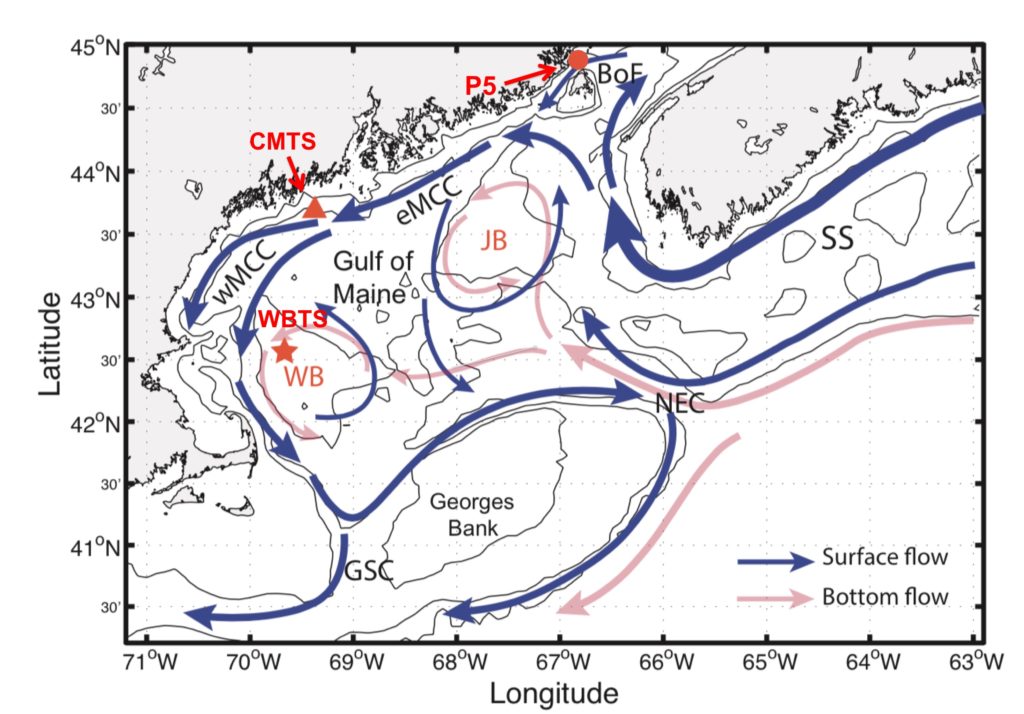
Fig. 1. Gulf of Maine geography and mean circulation, showing locations of three plankton survey stations: WBTS (Wilkinson Basin Time Series; red star marker), CMTS (Coastal Maine Time Series; red triangle marker) and P5 (Prince 5 from Canada’s AZMP program; red circle marker). BoF: Bay of Fundy; NS: Nova Scotia; SS: Scotian Shelf; NEC: Northeast Channel; GB: Georges Bank; GSC: Great South Channel; WB: Wilkinson Basin. Isobaths represent 50, 100 and 200 m.
Calanus finmarchichus, a foundation species for the ecosystem
Supporting the Gulf of Maine community at the top of the food web is a planktonic community with its own subarctic characteristics. We have identified a planktonic copepod, Calanus finmarchicus, as a key foundation species in the Gulf of Maine food web (Figure 2). One of the region’s largest copepod species, C. finmarchicusis remarkably abundant throughout its subarctic North Atlantic range and especially in the Gulf of Maine, where it serves a primary prey for herring and other forage fish and for the endangered North Atlantic right whale, which can feed on millions of the rice-sized life stages of the copepod each day.
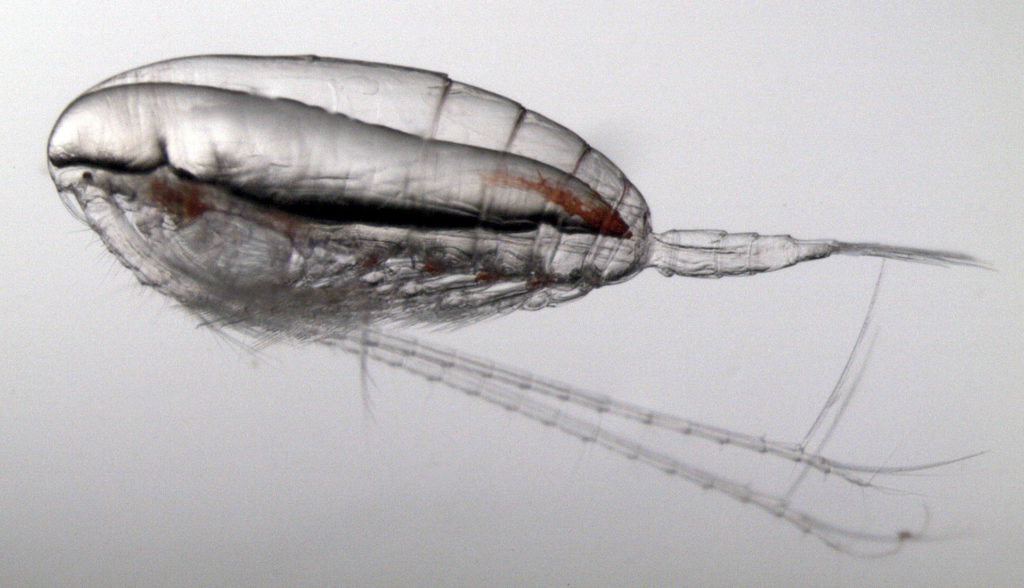
Figure 2. Late stage Calanus finmarchicus with oil sac, a primary source of energy for the planktivorous fish, such as herring, sand lance and capelin, that support harvested fish production in the subarctic North Atlantic Ocean. Late stage C. finmarchicus are also the primary prey of the endangered North Atlantic right whale.
The life history of Calanus finmarchicusis perfectly adapted to the subarctic seasonal cycle of primary production. The copepods start reproduction in late winter and early spring as the planktonic algal production is increasing. As they develop, Calanusaccumulates lipids produced by the planktonic algae, and by its last preadult life stage it has stored a large quantity, relative to its overall body size, of the liquid high energy fats that enable it to overwinter at depth starting in late summer. Herring, right whales and other planktivores in the Gulf of Maine are tuned to the C. finmarchicuslife cycle and eat large quantities of the lipid rich stages to fuel their energy needs and supply materials for production of offspring. In a sense, C. finmarchicus serves as a battery in the Gulf of Maine coastal ecosystem, storing in the water column the light energy converted by planktonic algae that in turn supports the higher Gulf of Maine community.
Zooplankton sampling
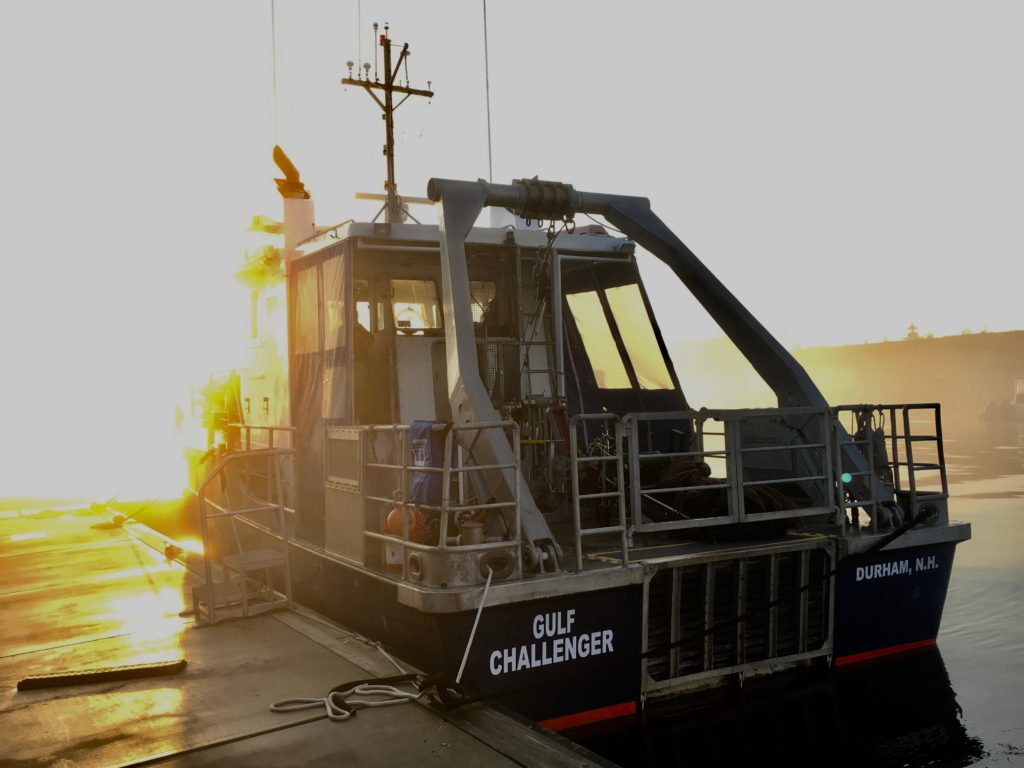
R/V Gulf Challenger at sunrise
The sampling is focused on a representative site, Wilkinson Basin Time Series (WBTS: 42.86 N, 69.86 W; depth: 225 m; see Figure 1).
In mid August 2016, a joint UMaine-WHOI team, consisting of 2 scientists, a technician and a postdoc conducted zooplankton sampling onboard the University of New Hampshire's R/V Gulf Challenger. Using a 0.25 square meters Multiple Opening and Closing Net, with an Environmental Sensing System (MOCNESS) and a Video Plankton Recorder (VPR), we measured the vertical distribution of C. finmarchicus at a station in the Maine Coastal Current and in Wilkinson Basin.
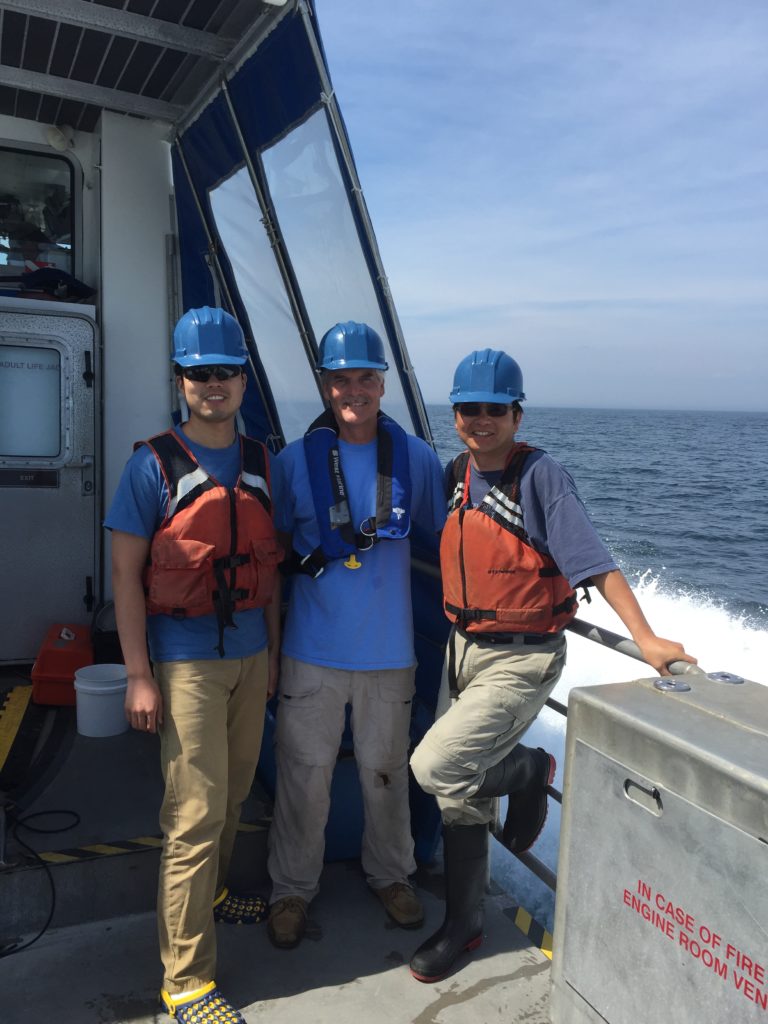
WHOI team from left to right: Zhixuan Feng (postdoc), Cabell Davis (scientist emeritus), and Rubao Ji (senior scientist).
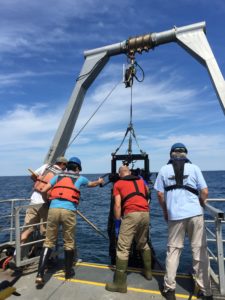
The team deployed MOCNESS.
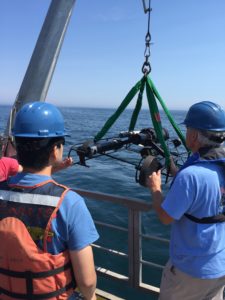
The team deployed VPR
Modeling
The individual-based model (IBM) is offline coupled to a high-resolution regional ocean model, Finite Volume Community Ocean Model-Gulf of Maine Version-3 (FVCOM-GOM3), and consists of two components: (1) a Lagrangian tracking model; (2) a copepod life cycle model. The Lagrangian tracking model solves the advection equation using a fourth order Runge-Kutta (RK-4) method. The stage- based life cycle model resolves copepod life stage progression through all 13 developmental stages based on temperature- and food-dependent development time (or rate). Satellite ocean color chlorophyll-a data are used for retrieving food conditions.
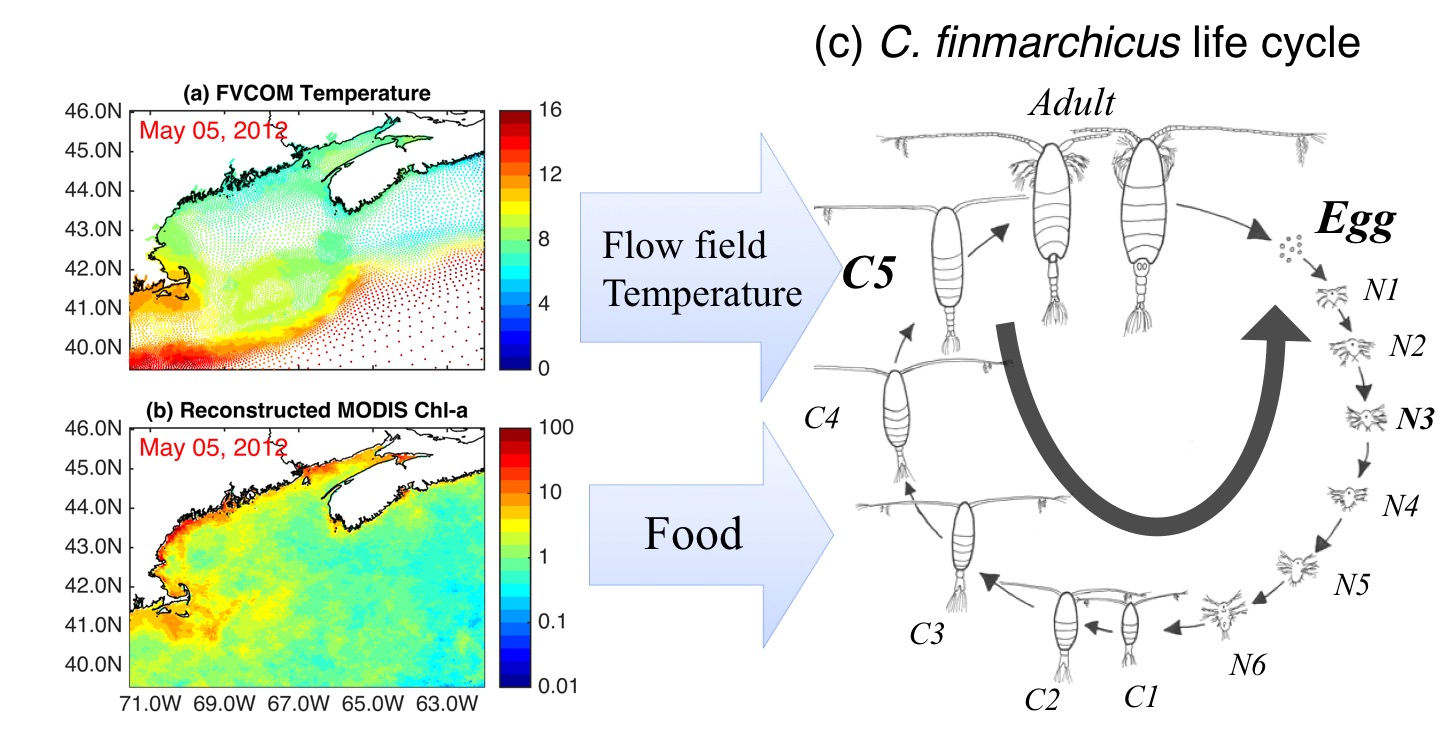
Figure 3. The offline model coupling between FVCOM and FISCM (see text for explanation of abbreviations). The FVCOM-simulated hourly flow fields are interpolated in the FISCM to obtain current velocities for Lagrangian tracking of C. finmarchicus individuals. FVCOM-simulated temperature and reconstructed MODIS chlorophyll-a concentration are also interpolated for use in calculating C. finmarchicus life history development. (a) A snapshot of FVCOM-simulated ocean surface temperature (°C) at 00:00 GMT May 5, 2012. The temperatures are plotted at corresponding FVCOM grid nodal points. (b) A snapshot of reconstructed chlorophyll-a concentration (mg m-3) in May 5, 2012. (c) 13 life stages of C. finmarchicus. N3 is the first feeding stage that food is required for life stage development, and C5 is the diapausing stage for C. finmarchicus. In the numerical experiments, all C. finmarchicus individuals are backward tracked and life stages are reversed from older to younger stages
Results
Model results
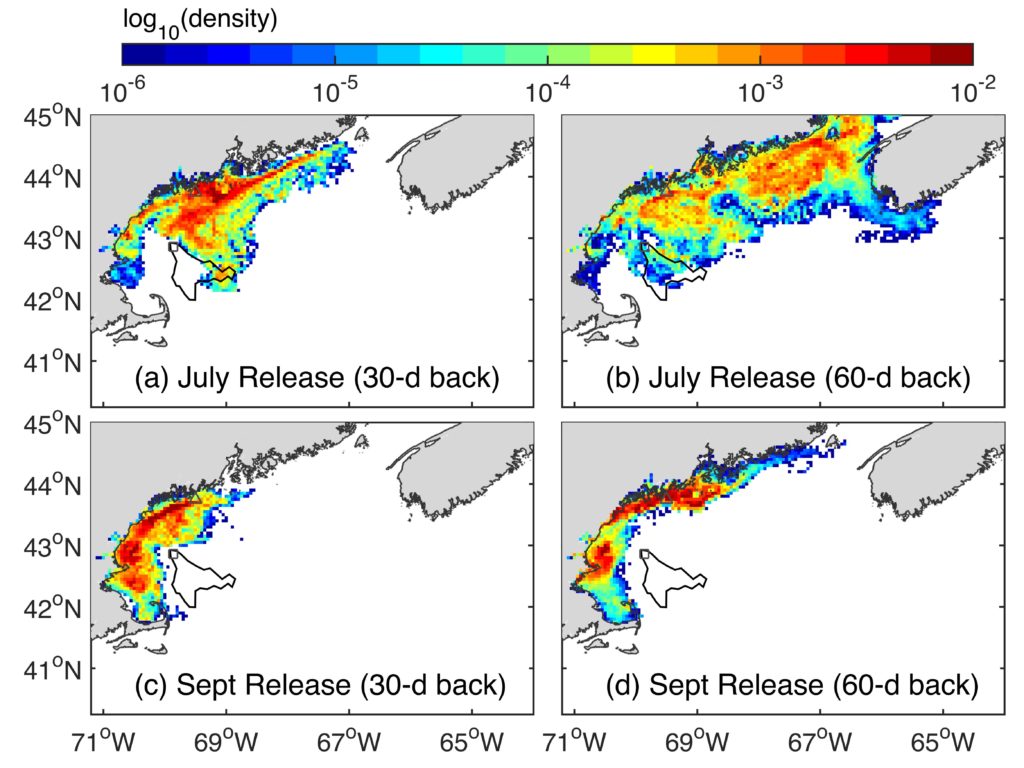
Figure 4: Passive, backward tracking of surface layer particles (no biology) in July after 30 and 60 d (Panels a and b) and in September after 30 and 60 d (Panels c and d). All particles are released within the black line polygon (220 m isobath of the Wilkinson Basin).
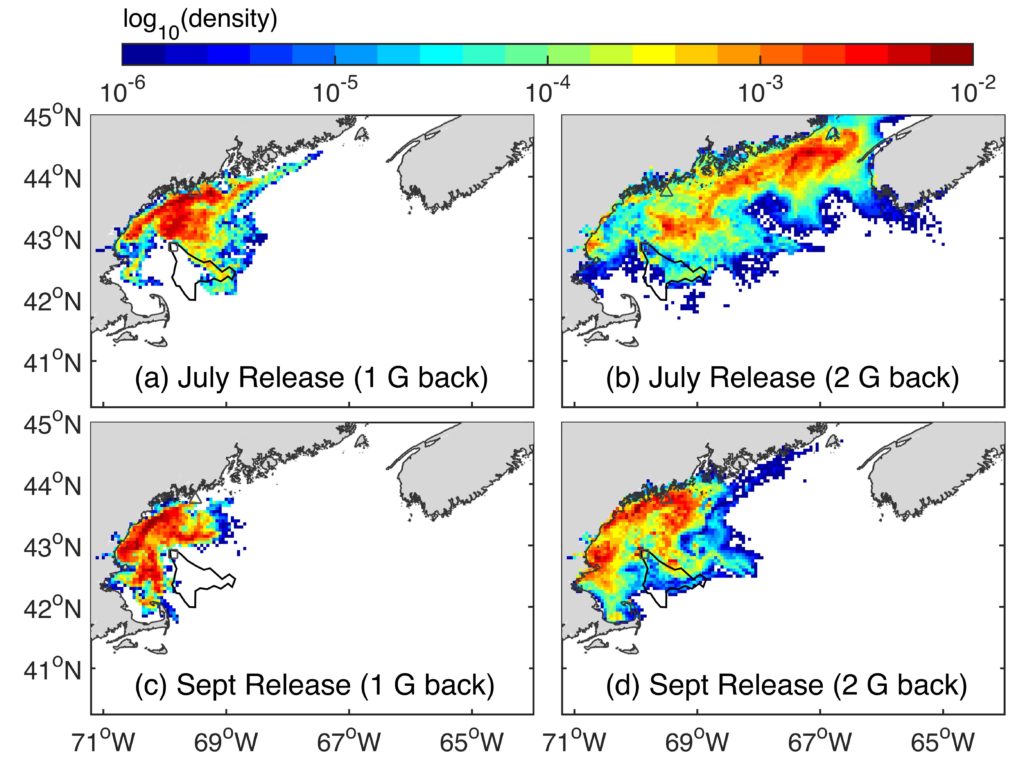
Figure 5: Potential C. finmarchicus egg spawning sites (source regions) that may seed WB C5 diapausing populations in July and September 2012. The egg spawning sites are determined by temperature and food-dependent backward-in-time tracking of C5 individuals from the WB to their source regions where individuals stage reverts to the egg stage. ‘1 G back’ indicates one generation back; and ‘2 G back’ indicates two generations back. All particles are released within the black line polygon (220 m isobath of the Wilkinson Basin).
Observations
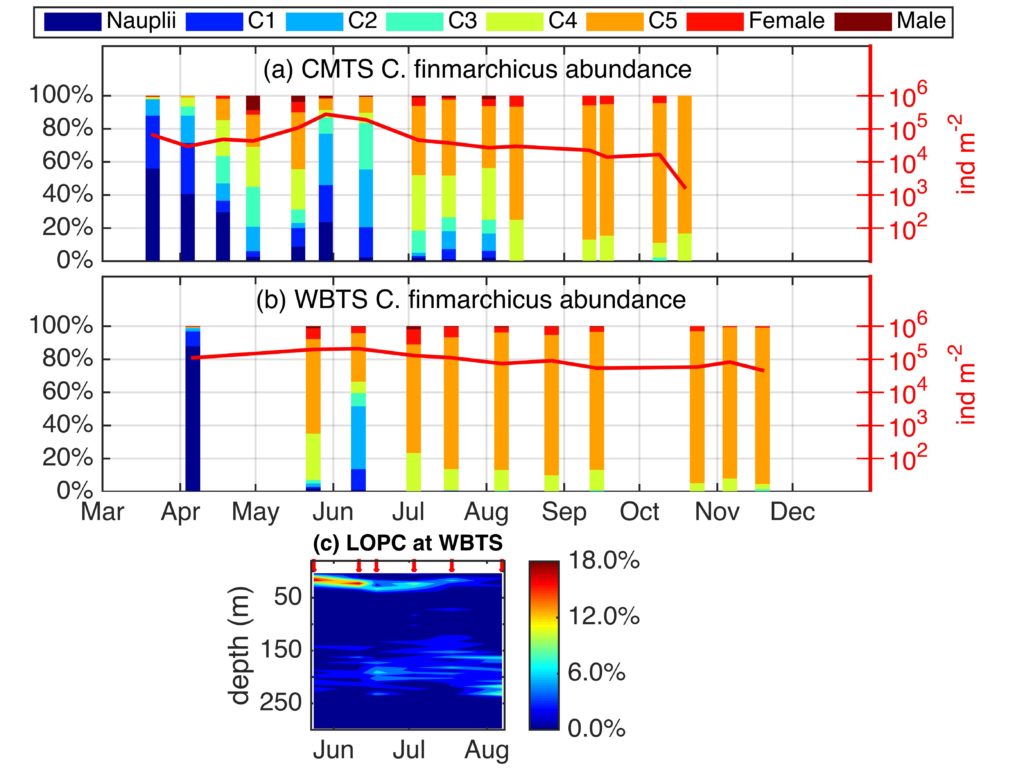
Figure 6: Total abundances and stage composition (relative abundances) of C. finmarchicus from March to November 2012 at (a) CMTS and (b) WBTS, and (c) profiles of particles characteristic of late-stage C. finmarchicus measured by the LOPC, shown as the proportion of particles in each depth bin. In first two panels, the total abundances (ind m-2) of C. finmarchicus are shown by red curves in the logarithmic scale. In the third panel, the red arrows indicate sampling dates.
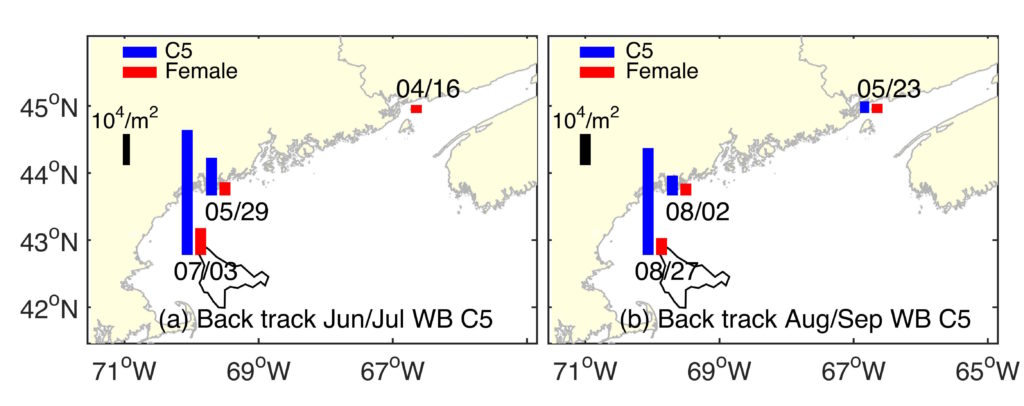
Figure 7: Observed abundance of C5 and adult female Calanus finmarchicus at the WBTS, CMTS and P5 during the dates that approximately match the advective timescale of water mass. a) Spring scenario: the upstream P5 station sampling time in mid April and the downstream WB station sampling time in early July; b) Summer scenario: the upstream P5 station sampling time in late May and the downstream WB station sampling time in late August.
Coastal Amplification of Supply and Transport (CAST)
Combining the models and the observational evidence, a conceptual model of Coastal Amplification of Supply and Transport (CAST) dynamics is illustrated here (Figure 8). The Bay of Fundy (BoF) is a potential source region that supplies the seed population to the downstream Maine coast and eventually reaching Wilkinson Basin (WB). The C5 individuals reach WB during early-mid summer (Fig 8, left panel) could be the direct offspring of the BoF adults or through one additional generation; whereas the C5 individuals reaching WB in later-summer and fall are more likely to go through 1 or 2 more generations. It is worth noting that this conceptual model needs to be investigated in future studies, ideally through a direct high-resolution observation of population structure along the Maine Coastal Current (MCC), such that the along-shelf stage succession from egg to nauplii and further to copepodites can be detected.
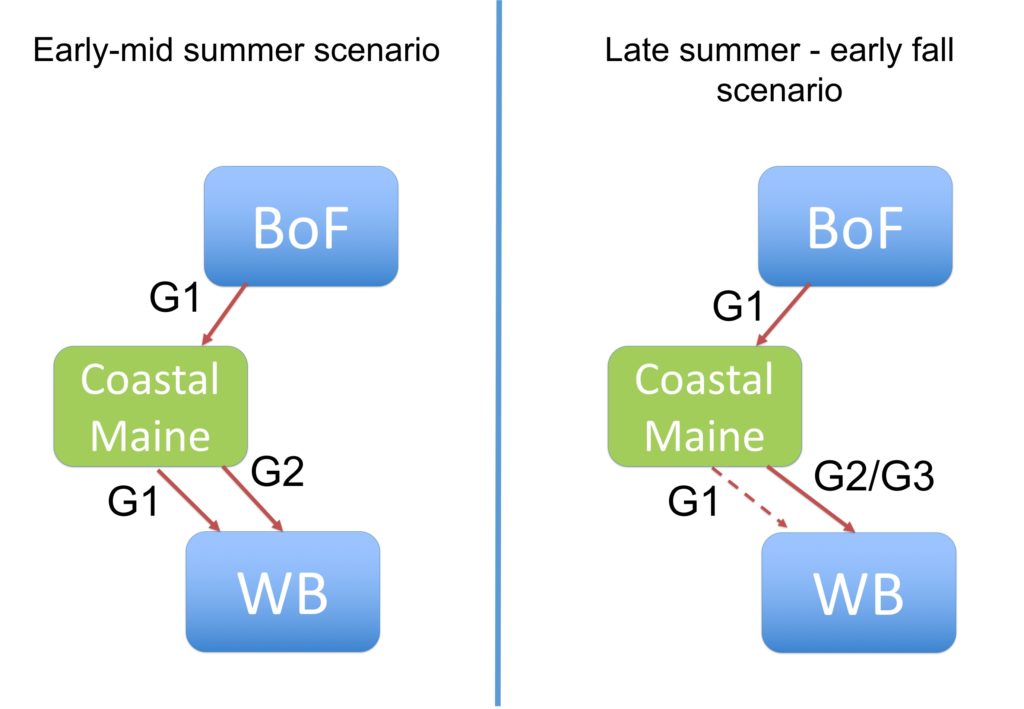
Figure 8: A conceptual model illustrating the connection from BoF to coastal Maine and eventually to WB through MCC. The population goes through 1 or 2 generations in the early - mid summer period (left panel) and 2-3 generations for the population in the late summer - early fall period (right panel) while being transported along the MCC.
Funding Agencies
The National Science Foundation Division of Ocean Sciences under award number 1459087, 1459133.
Partners/Collaborators
This is a joint project between University of Maine, University of Massachussets Dartmouth, Bigelow Laboratory for Ocean Sciences, University of New Hampshire, and Woods Hole Oceanographic Institution.
Lead PI: Jeffery Runge (University of Maine and Gulf of Maine Research Institute).
Co-PIs: Rubao Ji (Woods Hole Oceanographic Institution), Changsheng Chen (University of Massachussets Dartmouth), Nick Record (Bigelow Laboratory for Ocean Sciences), and Joe Salisbury (University of New Hampshire).
